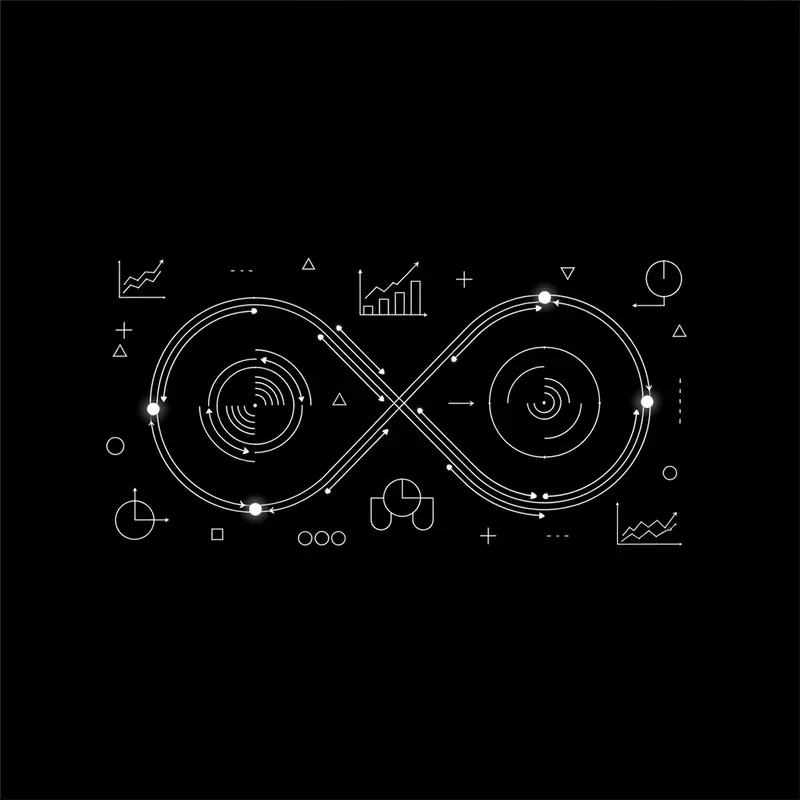
Most marketers are professional gamblers.
They spend weeks crafting a campaign, throw their budget at an algorithm, and pray for resonance. They treat the market like a slot machine rather than a system.
If you are reading this, you likely suspect that your 'customer research' is nothing more than educated guesswork. You are right.
The top 1% of creators do not guess. They do not rely on hope. They rely on simulation.
We are going to dismantle the belief that personas are passive PDF documents. We are going to rebuild them as active decision-making tools.
This is how you turn marketing from an art-form gamble into a systematic science.

You followed the best practices. You conducted the interviews. You aggregated the data. You built the beautiful slide deck.
You created "Corporate Dave." He is 42, wants a promotion, and loves ROI.
Yet, your campaigns fall flat.
The bleeding-neck issue isn't that you did the research wrong. It is that you treated a living, breathing market as a fossil.
Most creators and businesses rely on static snapshots of moving targets. You are trying to navigate a shifting terrain with a map drawn six months ago. We call this Persona Drift.
Research indicates that 89% of B2B personas are never updated after their initial creation. While your buyer's priorities shift with the market winds, your messaging remains frozen in time.
This creates an invisible degradation of quality. Your Click-Through Rate (CTR) drops 2-3% quarter over quarter. You blame creative fatigue or algorithm changes.
You are wrong.
It is a message-market mismatch. The "Corporate Dave" you defined in Q1 does not exist in Q3.
To make matters worse, the sudden influx of AI tools has industrialized this mediocrity. Most generated personas are essentially Mad Libs with better fonts. They scrape surface-level data without behavioral context. They produce demographic ghosts rather than decision-making humans because they lack the one thing that actually matters: proprietary interaction data.
If your insights come from the same massive dataset everyone else uses, you do not have an edge. You have a commodity.
It is time to stop guessing and start recalibrating.
To eliminate the drift and realign with reality, you must audit your foundation immediately.
The Age Gap Audit Look at your last 6 campaigns. Compare the launch date against the creation date of the persona used. Calculate the "Persona Age Gap." If any persona is older than 90 days, flag it immediately. In the current economy, 90 days is a geological era.
The Realism Stress Test Stop relying on generic prompts. Run a side-by-side test. Generate one persona using a standard tool, and one informed specifically by your CRM notes and sales call transcripts.
The Role-Play Validation Hand both profiles to your sales team or a trusted peer. Do not tell them which is which. Have them score both on "conversation realism." If the persona sounds like a marketing brochure rather than a confused human trying to solve a problem, burn it.

Once you realize your static map is useless, you will try to build a new one, but you will likely build it with the wrong materials.
You think you have an empathy problem. You actually have a data architecture problem.
Most teams treat AI personas like a creative writing exercise. They write a prompt saying, "Act like a CFO," and expect the machine to understand the visceral pressure of a Q4 budget cut. They rely on shallow demographics and generic firmographics behavior.
It fails. The output remains generic because the input was superficial.
The breakthrough isn't better prompting. It is building a memory system that mirrors how real customers accumulate context. High-performing teams do not settle for descriptions. They demand Cognitive Fidelity.
Your AI shouldn't just describe your buyer. It must simulate their decision calculus in real-time. A static profile cannot predict dynamic behavior.
To solve this, you must construct the persona using a layered data architecture:
Structure is useless without the right fuel. Most competitors rely on polite interviews. You must go deeper. You need the "Dark Data" the unspoken friction points that define actual buying behavior. The things they won't tell a salesperson, but will scream about in anonymity.
Here is how to transform your AI from a toy model into a prediction engine:
Implement the 4-Layer Stack Do not guess. Export 50+ CRM closed-won records, 20 sales call transcripts, and 10 win/loss interview recordings. Feed these into a fine-tuned model with role-specific embeddings to establish baseline Cognitive Fidelity.
Harvest the "Dark Data" Set up a pipeline for the ugly truth. Log competitor 1-star reviews to map dissatisfaction triggers. Export monthly support escalations to see what breaks trust. Use these datasets to teach the AI what pain actually feels like.
Map the Authentic Voice Use Phantombuster to scrape LinkedIn comments and Reddit threads from your ideal customer profiles. Capture the raw, unpolished language patterns they use when they think no one is selling to them.

You have built a digital brain with high cognitive fidelity, but it is useless if it sits in a silo gathering dust.
Your research lives in theoretical Miro boards, while your creative team operates in Figma and Slack. There is a gap between the insight and the execution. A "translation layer" where the sharp edge of the customer’s pain gets diluted by the designer's aesthetic preference.
You call this collaboration. In reality, it is persona handoff hell.
Most teams treat personas as ghosts in a PDF. You verify the strategy, hand it off, and hope the copywriter remembers the nuance. It fails.
The solution is not better documentation. It is Persona-as-a-Service.
You must stop asking, "What would Sarah think?" in a meeting room. That is a hallucination. Instead, you must embed the simulation directly into the workflow.
The shift is technical and psychological. You literally @-mention your AI persona in Slack alongside the creative brief. You force the draft through the filter of the persona's logic before a human stakeholder ever sees it. This moves the persona from advisory to prescriptive.
Consider the "Campaign War Game." One SaaS team thought their landing page was optimized. Human reviewers signed off on the copy. The design was clean. But before launch, they ran the AI persona through the campaign loop 100 times.
The simulation flagged a critical friction point: the page was missing a specific compliance badge. To the human creative director, it was clutter. To the CTO persona, it was a security risk.
The humans missed it. The simulation did not.
Fixing that single element before a dollar was spent increased MQL-to-SQL conversion by 31%.
Here is how to integrate this system:
Build the Slack Integration Create an AI persona bot that can be summoned in creative channels. Train it specifically to flag "deal-killer objections" regarding message clarity and emotional resonance.
Run Pre-Launch Simulations Do not launch on a guess. For every major campaign, run 50 simulated persona journeys through the full funnel.
Enforce the Drop-Off Rule Document every friction point found by the AI. Require resolution before budget activation. Do not hope for resonance. Engineer it.

Now that your simulations are running, you will feel the urge to measure speed, but this is a trap that leads to mediocrity.
You have built the system. The personas are active. But here is where most creators lose the plot: they fall into the trap of "efficiency."
They measure success by vanity metrics. They obsess over adoption rates or time-to-create. They celebrate generating ten assets in the time it used to take to write one.
This is a mistake.
Speed is irrelevant if you are accelerating towards a cliff. If you scale garbage, you do not get growth; you get noise. The goal of a Deep Game system is not to move faster, but to predict better.
We must shift your metrics from Output to Outcome.
Forget the volume. To prove quality lift, you need to track Creative Confidence and Waste Reduction.
Creative Confidence Score This is the percentage of pre-launch AI persona simulations that predict actual post-launch performance within a 15% variance. Your target is >85% accuracy. You are measuring the AI's ability to mirror reality.
Waste Reduction Rate This is the percent of creative concepts killed in simulation that would have failed in the market.
One B2B team tracked this relentlessly. Their AI persona simulation prevented 11 bad campaign launches in six months. They didn't just save time; they saved $420,000 in media spend and protected their brand perception from dilution.
That is the ROI of silence. That is the value of the mistake you didn't make.
A static tool decays. A true system evolves.
The final multiplier is closing the loop. Most people run a campaign and move on. You will treat every result as training data. By feeding campaign results back into the persona, you create Compound Expertise.
After 20 campaigns, a generic AI remains the same. Your AI improves its simulation accuracy from 78% to 94%. It builds an institutional memory that survives team turnover.
Here is how you build the feedback loop:
It is the difference between a static tool and a learning co-pilot.
You now have a choice.
You can continue to operate in the dark, relying on static PDFs and gut instinct, hoping the market hasn't shifted beneath your feet.
Or you can build the system.
The future of marketing belongs to those who can simulate the outcome before they spend the budget. It belongs to those who value the ROI of silence.
Stop guessing. Start predicting.
Join the Deep Game Newsletter to download the full Persona Architecture Template.
We help high-performance creators build predictive marketing engines using AI personas.
The Enhanced Marketer Letter is your monthly dose of:
🚀 Cutting-edge AI marketing tactics
💡 Insider tips from my $17M+ campaign experience
🔬 Results from my latest AI experiments
🧠 Mind-bending ideas to inspire your next breakthrough
Don't let your competition outpace you in the AI revolution. Level up your marketing game today!